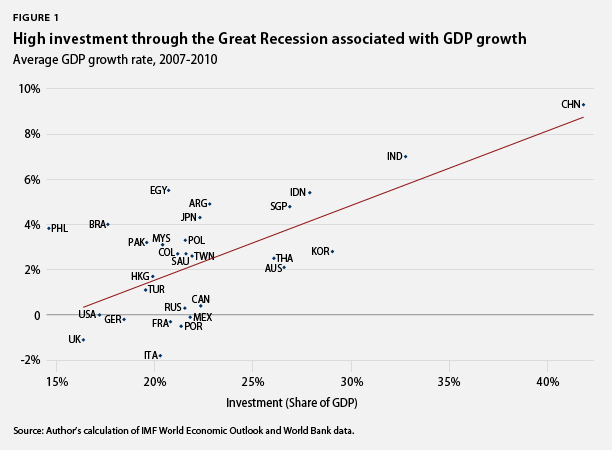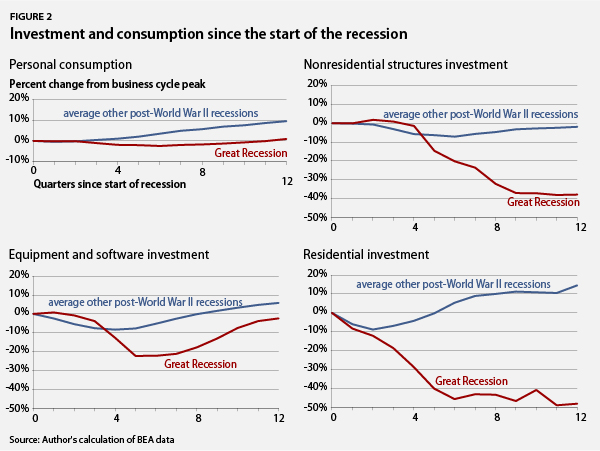By Adam Hersh | January 28, 2011
Washington, D.C.–The Commerce Department reports today that the economy grew by 3.2 percent in the fourth quarter and 2.9 percent overall in 2010, adjusted for inflation. Today’s figures show that the economy is now growing faster in the fourth quarter than its historical trend growth rate, and the sixth straight quarter of growth offers relief that the economy is gaining momentum. This is good news, but public and private investment—critical for our long-run growth and competitiveness—still lags behind. Around the world, countries with high sustained investment rates are leading the global recovery. Those with low investment risk being left out. And "recovery" has not yet come to millions of American families struggling with high unemployment, stagnant incomes, high home foreclosures, and the fear that their situation is being accepted by policymakers as the "new normal." To address these issues, economic policy needs to focus on strengthening investment now.
Gross domestic product, or GDP, measures the sum of all goods and services produced in the United States minus imports. It is the broadest indicator of the health and activity in our economy, including the consumption from households, investments by private businesses and the government, and the relative competitiveness of U.S. exports. GDP expanded to nearly $13.4 trillion in the last quarter of 2010, and for the first time it surpassed the peak of economic activity in December 2007 when the U.S. economy slid backward into the Great Recession.
A convenient way to understand the GDP numbers is to look at how different components contributed to the overall 3.2 percent growth rate. Growth was led by an improved trade balance, which accounted for 3.4 percentage points. Consumption from households accounted for the next largest share: 3 percentage points. Private investment shrank GDP by 3.2 percentage points. And shrinking government outlays took away 0.1 percentage points.
Expansion of personal consumption and an improvement in U.S. trade competitiveness led today’s growth numbers. Rebounds to consumption spending typically lead the exit from economic recession, and consumption exceeded its pre-recession level by $89 billion.
Personal consumption accounts for some 70 percent of overall GDP. When unemployment shoots up and family incomes decline in recessions, safety net policies play a critical role maintaining this substantial component of the economy. Progressive policies to continue providing unemployment insurance benefits and to drive private job creation through Recovery Act investments and tax cuts contributed directly to this consumption rebound.
But the largest contributor to growth in the fourth quarter was America’s trade balance, or “net exports”—the total goods and services exported abroad minus imported goods and services purchased from other countries. U.S. exports grew by $35 billion while imports shrank by $78 billion. As a result, the trade deficit shrank by $113 billion. The improved trade position in the fourth quarter was driven by a more competitive value of the U.S. dollar and slowing imports of foreign oil.
Acceleration of U.S. economic growth in 2010 is a welcome relief three years after the financial crisis plunged us into the Great Recession. But continued weak investment poses concerns for sustaining growth momentum and revitalizing dynamism in the U.S. economy. Gross private investment fell by $115 billion in the fourth quarter primarily because private businesses sold down their inventories accumulated earlier in the year. Excluding inventory sales, however, private business investment in overall buildings, factories, and equipment grew only $18 billion. Investment in new buildings and factories grew only $700 million.
The tepid investment recovery is particularly troubling given that in the 2001 to 2007 business cycle expansion, we’d already experienced the slowest investment growth rate since World War II. Making matters worse, much of that investment was misallocated into nonproductive residential and commercial real estate.
If economists agree on anything, it’s that investment is the key to long-run economic growth and prosperity. Figure 1 shows the relationship between high levels of investment and economic growth since the start of the Great Recession for the top 30 countries leading the global economic recovery. Taken together, these countries comprise 88 percent of total world GDP growth in 2010. The horizontal axis measures countries’ investments in public and private investments (buildings, factories, schools, machinery and equipment, and physicalinfrastructure) as a share of national income. The vertical axis measures countries’ average annual real GDP growth rates since the Great Recession began in December 2007. The upward sloping line shows a clear positive relationship between investment and economic growth.

The message from this data is crystal clear: We need to invest more to compete and lead economically. China, India, Indonesia, South Korea, Australia, Peru, Argentina, and others are making strong investments and enjoying high growth that propels the global economy. Countries such as the United States, Great Britain, and Germany, which are making relatively low investments and cutting public budgets, are growing slowly or falling behind.
Investment growth is also lagging far behind the pace of previous economic recoveries. Figure 2 shows the real dollar change in consumption and the various components of investment since the start of the Great Recession. The current path is compared to the average performance of these indicators for all other post-World War II recessions. In the top left panel we can see that personal consumption, while rebounding, is coming back slower than experienced in previous recessions. There was a steep loss of household wealth and high indebtedness following the real estate bubble and the unprecedented level of long-term unemployment in this recession. That consumption did not fall farther is a testament to the critical importance of safety net policies like unemployment insurance and the Recovery Act that made investments to stimulate private job creation.

While consumption is recovering, investment has fallen off sharply, with growth well behind the pace of previous economic recoveries.
Business equipment and software investment, in the top right panel, stands 2.4 percent below its peak level three years after the start of the recession. At this point in previous recessions, equipment investment had on average expanded 5.7 percent beyond the peak.
The fall-off in investment has been most protracted for buildings, factories, and homes. Investment in nonresidential structures, in the lower left, has dropped 38 percent below its pre-recession level. On average in prior recessions, nonresidential structures investment fell only as low as 7 percent and by now would be nearly recovered to pre- recession levels. Residential investment is now 47 percent below its December 2007 level.
Depressed residential investment is unsurprising given the magnitude of overinvestment during the housing bubble. But the critical hole this investment shortfall leaves in GDP serves as a prescient reminder of how important strong financial regulatory policies are for encouraging productive investment maintaining stable economic growth.
Low investment is not due to the cost or availability of capital. Interest rates on corporate AAA bonds stand at just more than 5 percent, the lowest persistent interest rates since 1966. The nonfarm, nonfinancial business sector is holding more than $1.9 trillion in cash, totaling 7.4 percent of total corporate assets in the third quarter of 2010—the highest percentage since the fourth quarter of 1959. And banks are holding more than $1 trillion in excess reserves at the Federal Reserve.
Business investment is lagging because of concerns about future business competitiveness and where sales growth will come from when unemployment is at 9.4 percent.
President Obama’s call to focus on making investments for the future in infrastructure, innovation, and education could not come at a more critical time. These investments will put people back to work now while helping lower costs for private businesses and giving them the confidence to invest again. Policymakers preparing to debate the federal budget need to strike a balance between managing the deficit and ensuring America will make critical investments now to secure our competitive future.
To read the full column, click here.
To speak to Adam Hersh, please contact Megan Smith at 202.741.6346 or via email at [email protected].
###